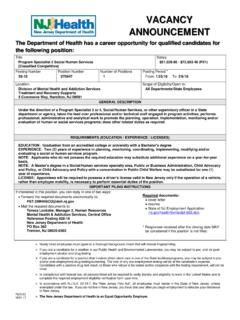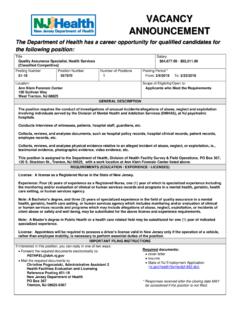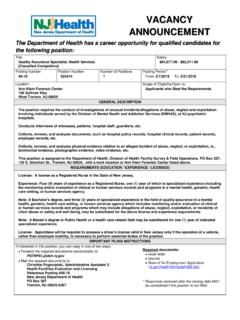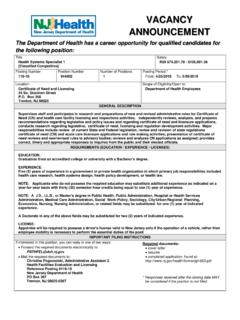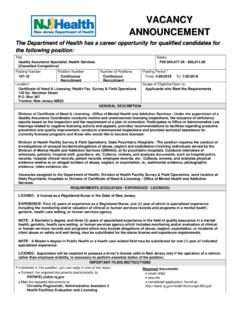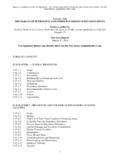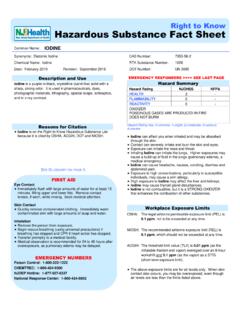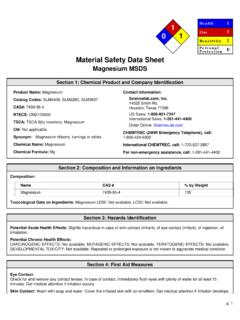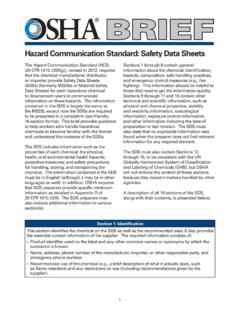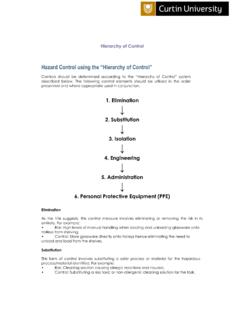Transcription of N-NITROSO-N-METHYLUREA HAZARD SUMMARY …
1 Common Name: N-NITROSO-N-METHYLUREA CAS Number: 684-93-5 DOT Number: None ---------------------------------------- --------------------------------- HAZARD SUMMARY * N-NITROSO-N-METHYLUREA can affect you when breathed in. * N-NITROSO-N-METHYLUREA should be handled as a CARCINOGEN and a TERATOGEN--WITH EXTREME CAUTION. * Contact can irritate the skin and eyes. * High exposure may cause headache, nausea and vomiting. * N-NITROSO-N-METHYLUREA may cause a skin allergy. If allergy develops, very low future exposure can cause itching and a skin rash.
2 * N-NITROSO-N-METHYLUREA may damage the liver. IDENTIFICATION N-NITROSO-N-METHYLUREA is a pale yellow sand-like solid. It is used as a research chemical and cancer medication. REASON FOR CITATION * N-NITROSO-N-METHYLUREA is on the Hazardous Substance List because it is cited by NTP, DEP, IARC and EPA. * This chemical is on the Special Health HAZARD Substance List because it is a CARCINOGEN and TERATOGEN. * Definitions are provided on page 5. HOW TO DETERMINE IF YOU ARE BEING EXPOSED The New Jersey Right to Know Act requires most employers to label chemicals in the workplace and requires public employers to provide their employees with information and training concerning chemical hazards and controls.
3 The federal OSHA HAZARD Communication Standard, , requires private employers to provide similar training and information to their employees. * Exposure to hazardous substances should be routinely evaluated. This may include collecting personal and area air samples. You can obtain copies of sampling results from your employer. You have a legal right to this information under OSHA * If you think you are experiencing any work-related health problems, see a doctor trained to recognize occupational diseases.
4 Take this Fact Sheet with you. RTK Substance number: 1411 Date: December 1995 Revision: July 2001 ---------------------------------------- --------------------------------- WORKPLACE EXPOSURE LIMITS No occupational exposure limits have been established for N-NITROSO-N-METHYLUREA . This does not mean that this substance is not harmful. Safe work practices should always be followed. * N-NITROSO-N-METHYLUREA may be a CARCINOGEN in humans. There may be no safe level of exposure to a carcinogen, so all contact should be reduced to the lowest possible level.
5 WAYS OF REDUCING EXPOSURE * Enclose operations and use local exhaust ventilation at the site of chemical release. If local exhaust ventilation or enclosure is not used, respirators should be worn. * Wear protective work clothing. * Wash thoroughly immediately after exposure to N-NITROSO-N-METHYLUREA and at the end of the workshift. * Post HAZARD and warning information in the work area. In addition, as part of an ongoing education and training effort, communicate all information on the health and safety hazards of N-NITROSO-N-METHYLUREA to potentially exposed workers.
6 * The FDA (Food and Drug Administration) has set standards for Good Manufacturing Practices for Drugs and Pharmaceuticals. These should be followed for your protection as well as product quality. See the FDA regulation 21 CFR 210. N-NITROSO-N-METHYLUREA page 2 of 6 This Fact Sheet is a SUMMARY source of information of all potential and most severe health hazards that may result from exposure. Duration of exposure, concentration of the substance and other factors will affect your susceptibility to any of the potential effects described below.
7 ---------------------------------------- ----------------------------------- HEALTH HAZARD INFORMATION Acute Health Effects The following acute (short-term) health effects may occur immediately or shortly after exposure to N-NITROSO-N-METHYLUREA : * Contact can irritate the skin and eyes. * High exposure may cause headache, nausea and vomiting. Chronic Health Effects The following chronic (long-term) health effects can occur at some time after exposure to N-NITROSO-N-METHYLUREA and can last for months or years: Cancer HAZARD * N-NITROSO-N-METHYLUREA may be a CARCINOGEN in humans since it has been shown to cause cancer of the nervous system, stomach and skin in animals.
8 * Many scientists believe there is no safe level of exposure to a carcinogen. Reproductive HAZARD * N-NITROSO-N-METHYLUREA may be a TERATOGEN in humans since it has been shown to be a teratogen in animals. Other Long-Term Effects * N-NITROSO-N-METHYLUREA may cause a skin allergy. If allergy develops, very low future exposure can cause itching and a skin rash. * N-NITROSO-N-METHYLUREA may damage the liver. MEDICAL Medical Testing Before beginning employment and at regular times after that, the following is recommended: * Evaluation by a qualified allergist, including careful exposure history and special testing, may help diagnose skin allergy.
9 Any evaluation should include a careful history of past and present symptoms with an exam. Medical tests that look for damage already done are not a substitute for controlling exposure. Request copies of your medical testing. You have a legal right to this information under OSHA WORKPLACE CONTROLS AND PRACTICES Unless a less toxic chemical can be substituted for a hazardous substance, ENGINEERING CONTROLS are the most effective way of reducing exposure. The best protection is to enclose operations and/or provide local exhaust ventilation at the site of chemical release.
10 Isolating operations can also reduce exposure. Using respirators or protective equipment is less effective than the controls mentioned above, but is sometimes necessary. In evaluating the controls present in your workplace, consider: (1) how hazardous the substance is, (2) how much of the substance is released into the workplace and (3) whether harmful skin or eye contact could occur. Special controls should be in place for highly toxic chemicals or when significant skin, eye, or breathing exposures are possible.

